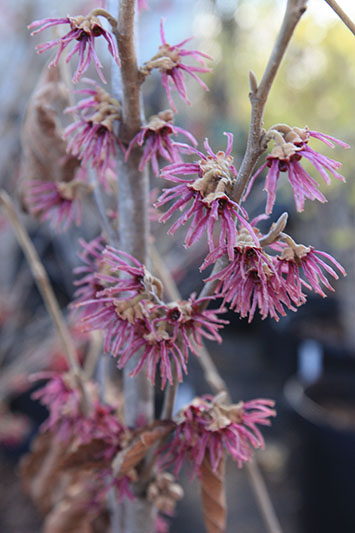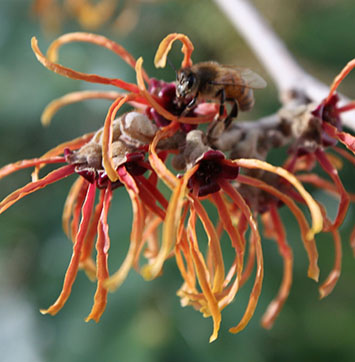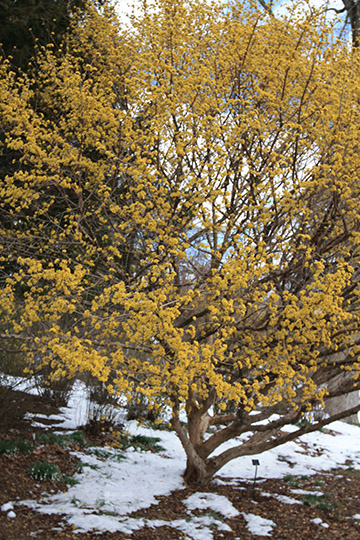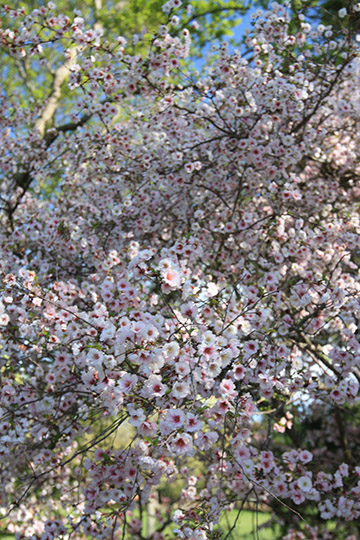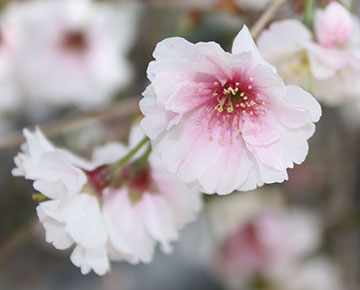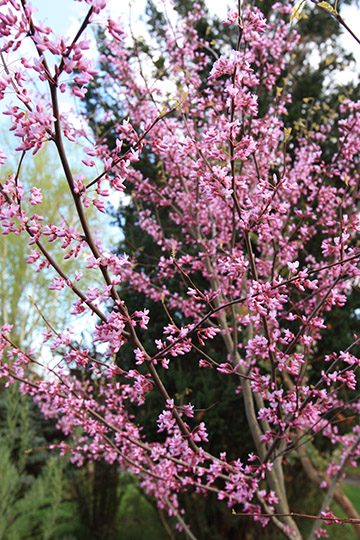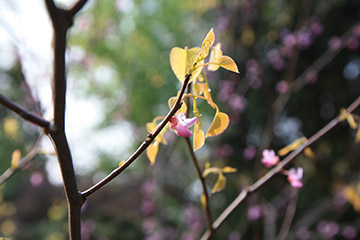Spring 2018 Newsletter
Magnolia ManiA ReVisited
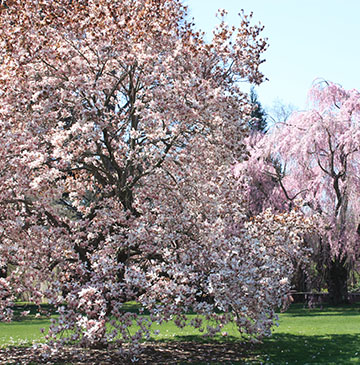 |
Magnolias are blooming! Though some of the early blooming species were damaged by the recent extreme cold snap, our Magnolia stellata ‘Waterlily’ in the nursery display garden is continuing to open with a flurry of fragrant flowers. Magnolias are part of the chorus that heralds a colorful, fragrant and prolific gardening season.
E. H. “Chinese” Wilson, horticulturist, prolific plant explorer and successor of Charles S. Sargent as Director of the Arnold Arboretum in Boston proclaimed of Magnolia: "Aristocrats of ancient lineage, possessed of many superlative qualities are the magnolias. They have the largest flowers and largest individual leaves of any hardy group of trees. No other genus of hardy and half-hardy trees and shrubs can boast so many excellences ... Their free-flowering character and great beauty of blossom and foliage are equalled by the ease with which they may be cultivated."
If visual memories are the most deep-felt of our five senses, Magnolias are strongly imprinted in my horticultural intuitiveness. Focused on gardening by the age of six, I savored many plants and gardens, from those of my mother, great aunt and neighbors to the imposing estates on the coast of Maine. However, I distinctly remember seeing my first Magnolia when I was thirteen. We were visiting my older brother at Bowdoin College in Brunswick, Maine. It was a saucer magnolia (Magnolia x soulangeana) and so exotic, like a tree full of tulips! Years later, at the University of Maine campus in Orono, I would discover more Magnolias. Perhaps the most memorable for its giant two foot long leaves was the umbrella magnolia (Magnolia tripetala) growing near the greenhouses by Deering Hall. Magnolia macrophylla subsp. asheisports incredible, tropical sized leaves three feet long!
In later years, when I traveled south to explore gardens in Charleston, South Carolina and Savannah, Georgia, it was the magnificent glossy evergreen foliage of Magnolia grandiflora that awed me. Nineteenth century American artist Martin Johnson Heade captured the essence of this 'elegant aristocrat' on canvas. Northern gardeners with "Zonal Envy" can grow the cultivar 'Bracken Brown Beauty' in a niche micro-climate. This iconic southern magnolia is growing in a garden near Worcester, MA.
The Sweet Bay Magnolia (Magnolia virginiana) enamored early Seventeenth Century British plant enthusiasts. It has an extensive native range from the town of Magnolia, Massachusetts on Cape Ann south to Florida. Its glossy white, sweetly scented flowers bloom in June. I am especially fond of the hardy evergreen forms of Magnolia virginiana var. australis. The evergreen cultivar 'Henry Hicks', selected by the Scott Arboretum, is outstanding year-round. The Arnold Arboretum's collection includes several other evergreen form such as 'Milton'.
Greeting gardeners near the entrance to the Arnold Arboretum is the Yellow blooming Magnolia ‘Elizabeth' hybrid child of North American Magnolia accuminata and the Asian Magnolia denudata. It is perhaps the most recognized yellow flowering magnolia. A stunning specimen can be experienced near the entrance to the Arnold Arboretum. The Magnolia collection at the Scott Arboretum in Swarthmore, PA is well worth a visit. One of my favorites is Magnolia denudata 'Swarthmore Sentinel', a stunning upright form dressed in white flowers.
Boston boasts spectacular displays of Magnolias, from The Arnold Arboretum of Harvard University in Jamaica Plain to Commonwealth Avenue. Fifty three years ago, in 1963, civic activist Laura Dwight launched a community-wide drive to beautify the Back Bay. She recruited a group of volunteers, who planted the first saucer magnolias (Magnolia soulangeana) and Star Magnolias (Magnolia stellata) along Commonwealth Avenue. In 1995, The Garden Club of the Back Bay oversaw a second planting of more than forty Magnolia x ‘Leonard Messel’ -- adding to the spectacular spring display.
A few years ago, I moved a mature, thirty year old Star Magnolia (Magnolia stellata) from a client's old house to a new house and garden in Woodstock, Connecticut. We dug an eight foot diameter root ball! Magnolia stellata's fragrant white flowers and silvery grey bark and graceful form anchor the entrance garden, well worth the effort.
Its been forty six years since my thrill of seeing a 'tree full of tulips' and I am not yet sated. Explore the many Magnolias at Tranquil Lake Nursery, I'm sure they will captivate you too.
by Warren Leach, Landscape Horticulturist and owner of Tranquil Lake Nursery, Rehoboth, MA.
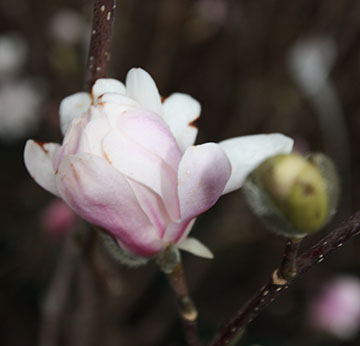 |
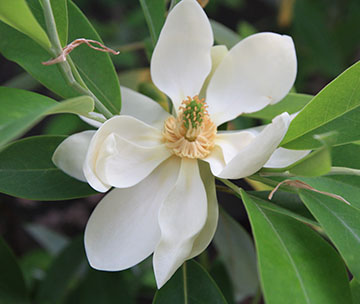 |
Magnolia stellata 'Waterlily' |
Magnolia 'Henry Hicks' |
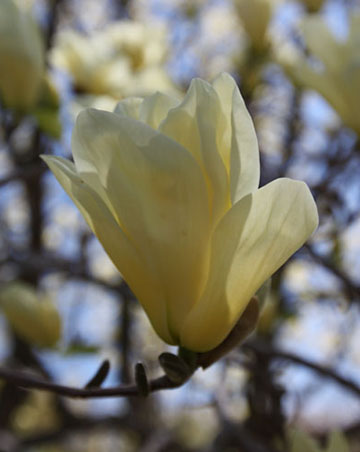 |
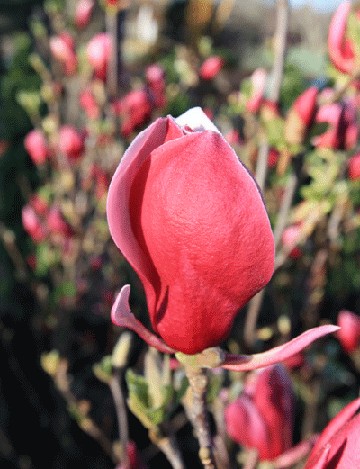 |
Magnolia 'Elizabeth' |
Magnolia 'March Till Frost' |
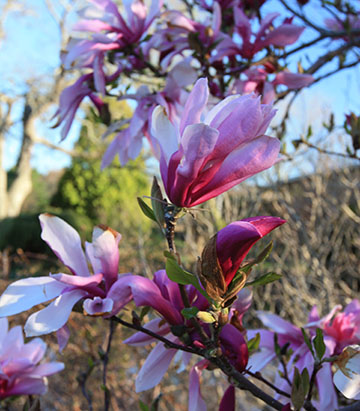 |
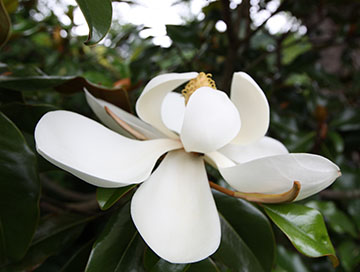 |
Magnolia 'Jane' |
Magnolia 'Bracken Brown Beauty' |
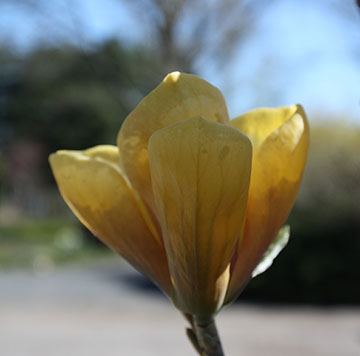 |
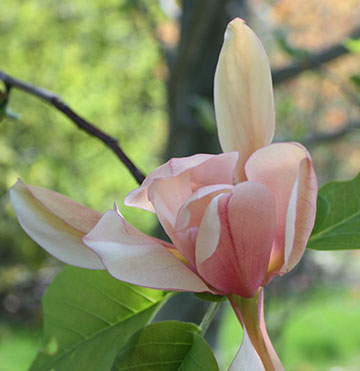 |
Magnolia 'Judy Zuk' |
Magnolia 'Peachy' |
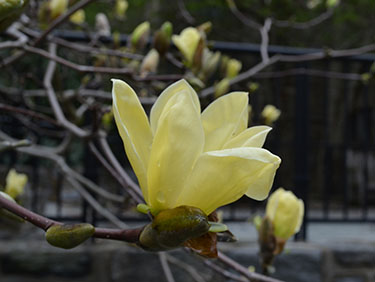 |
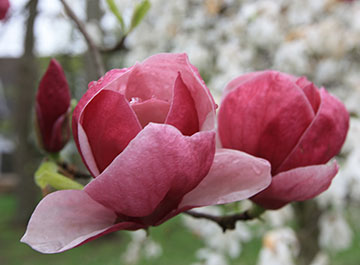 |
Magnolia 'Golden Girl' |
Magnolia soulangeana 'Rustica Rubra' |
Early Spring Bloom
Our gardens celebrate the renewal of life with colorful spring blooming crocuses and fragrant witch hazels. The witch hazels have bravely bridged the garden season from winter to spring. Hamamelis vernalis ‘Amethyst’ has been in bloom for nearly two months, first unfurling spidery flowers at the end of December. Amethyst has shrugged off snow and cold, even the extreme of 9 degrees F. below zero. Hamamelis mollis ‘Wisley Supreme’ is the most fragrant witch hazel with large, lemon-yellow flowers. Witch hazels will grow in full sun or partial shade and even in containers. They mature to a large shrub, 10 to 20 feet tall. Hamamelis x ‘Jelena’, ‘Diane’, Hamamelis japonica ‘Shibamichi Red’ and Hamamelis mollis ‘Wisley Supreme’ have joined in the flurry of colorful winter flowers.
Following the witch hazels in late winter are the early spring blooms of Cornelian Cherry Dogwood (Cornus mas), a small tree that reaches 20-25 feet at maturity and is hardy to Zone 4. It sports yellow puffs of flowers in early spring, followed by red fruits and yellow fall foliage. It even has attractive exfoliating bark on older trunks and branches to bridge the winter season. Because of its early seasons, Cornus mas branches are favorites for forcing cut branches into early bloom in the gloom of February, along with branches of forsythia. Cornus mas ‘Spring Glow’ is a show stopping cultivar that is smothered with hundreds of bright yellow starburst flowers in early spring. It blooms two weeks earlier than other Cornus mas cultivars. Leathery, dark green leaves adorn the plant throughout the growing season. Thicker and glossier than other cultivars.
Magnolia stellata, the star magnolia sports fat, fuzzy, flower buds whose silky filaments glow incandescent in the winter sun. In early spring the bare branches are covered in white starburst blooms with a hint of pink. Each flower is double with a delicate perfume. The cultivar ‘Waterlily’ blooms a few weeks later than the typical star magnolia, which protects it from late frosts. The star magnolia is a beautiful small tree with attractive silver-gray bark. ‘Waterlily’ grows into a large rounded shrub or can be trained to a small tree 10 feet tall and 10 feet across, with a pyramidal form. Best grown in full sun to partial shade in moist organically rich soils with regular moisture. Zone 5 to 9. Nice in a small garden or in the mixed border.
The best flowering cherry for small gardens is Prunus x ‘Hally Jolivette’. It may be small in stature, 12 to 15 feet, but 'Hally Jolivette' is clothed with delicate pink flowers that bloom for an exceptional long season. The glossy foliage is dark green and turns red for fall color. Plant 'Hally Jolivette' in full sun to partial shade as a spring shows-topper in the mixed border.
The Eastern Redbud, Cercis canadensis, is a native tree to the southeastern and central U. S. from New Jersey South. In April the bare branches are covered with tiny but showy, purplish-pink, pea-like flowers in clusters of 4 to 8. The heart-shaped leaves appear after the flowers and turn yellow in autumn. The tree grows 20 to 30 feet tall and spreads 25 to 35 feet in width. The shape is rounded to broad with a flattened top with upright branching. Best in full sun to light shade with moist, well-drained deep soil. Cercis canadensis ‘Alba’ is a white flowering form. There are also a few cultivars with dramatically colored leaves. ‘Hearts of Gold’ has leaves that emerge red, maturing to gold and are burn resistant even in full summer sun. The leaves of ‘The Rising Sun’ emerge deep golden orange and matures through shades of orange, gold and yellow to a speckled lime green. New leaves appear throughout the summer, resulting in a mix of colors. ‘Forest Pansy’ is a purple leaved cultivar with attractive orange and purple fall color. Any of these small native trees are a beautiful addition to the garden.
Our native Shad tree (Amelanchier canadensis) blooms in early spring around the time when the shad migrate upstream. The white flowers are followed by sweet blue fruit in June, a favorite of birds. As a child, we called them sugar-plums and competed with the birds for a tasty treat. The shad tree can be grown as a single or multi-trunk small tree. It has beautiful gray bark and orange fall foliage color.
Mahonia bealei, the leather-leaf mahonia is an evergreen shrub with typically grows in a multi-stemmed clump 4 to 6' tall. Leathery, pinnate-compound, holly-like leaves (to 12-18" long) grow in horizontal tiers. Each leaf has 5-8 pairs of narrow, stiff-toothed, dark green leaflets. Fragrant yellow flowers bloom in late winter followed by waxy green fruits which hang in grape-like clusters. Fruits are attractive to birds. Plant in full to part shade in moist, well-drained soil. Mahonia bealei is drought tolerant.
The yellow flowers of Golden Winter Hazel (Corylopsis spicata ‘Aurea’), brighten any corner in very early spring. Bright yellow leaves emerge from elegant rose protective leaf scales following bloom and stay golden through to fall. A beauty from March to October. Mature size of 5-6 feet tall by 5-6 feet wide, with a graceful and open form. Appreciates soil with adequate moisture and some shade to keep the leaves looking good. Site in a cool spot to delay breaking dormancy as long as possible, as the very early flowers can be damaged by frost.
The cultivar of Sweet Box, Sarcococca hookeriana var. humilis ‘Fragrant Valley’ is very fragrant and very early white flowers on this sweet box variety that has a low growing habit. An ideal cold hardy ground cover for shade. Sarcococoa grows 18 to 24 inches tall and 3 to 4 feet wide with lustrous lance-shaped dark green, glossy evergreen leaves. It spreads slowly by suckering and looks good naturalized at the base of small trees. Plant in part to full shade in average, moist, well-drained garden soil. Sweet box is also deer resistant.
Pieris x ’Katsura’, the dwarf variety of Japanese Andromeda offers dramatic, deep wine-red new growth continues to emerge throughout the summer, turning to bright glossy green leaves with good red fall color. Arching racemes of pink flowers in early spring make a striking combination with early bulbs. Excellent in a container on a shady patio. Pieris x ‘Katsura’ grows to a compact mounding habit three to four feet tall and wide in five years. Plant in part shade in moist, well-drained acidic soil. It too is deer resistant.
Accompanying the witch hazels are the brightly colored flower buds of Pieris japonica ‘Dorothy Wycoff’. This Japanese andromeda, also known as the lily-of-the-valley shrub, is clothed with very glossy, dark green leaves. The stems are terminated with bright red flower buds arranged in red, pendulous racemes. This beautiful, winter composition of red and green will transform in early spring into abundant clusters of fragrant white bells tinged with pink.
Spiraea thunbergii ‘Ogon’ is one of my favorite shrubs. A true workhorse, with beauty from spring to fall. Spiraea ‘Ogon’ greets you in early spring with chartreuse foliage and arching branches sporting clusters of white flowers. It is easy to accommodate in any garden, happy in partial shade or full sun, it forms a fine-textured colorful mound to four feet. It’s fresh-spring chartreuse foliage is attractive all summer and turns pumpkin-orange in October. Contrast Spirea’s fine textured foliage with the bold dark green, evergreen leaves of Mahonia bealei.
Warren P. Leach
|
|
Hamamelis vernalis 'Amethyst' bloomed in February. |
Hamamelis x. 'Jelena' is one of the earliest witch hazels to bloom, sometimes as early as late December. |
|
|
|
|
Hamamelis japonica 'Shibamichi Red' for colorful late winter bloom. |
Cornus mas, the Cornelian Cherry Dogwood blooms in late March to early April. |
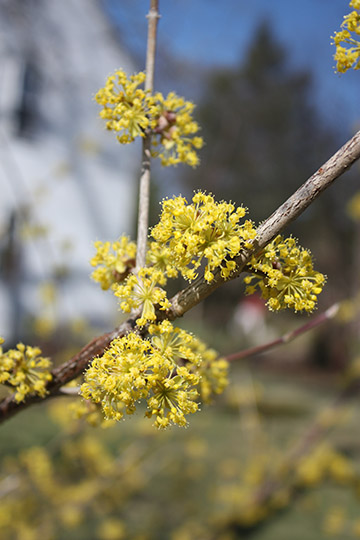 |
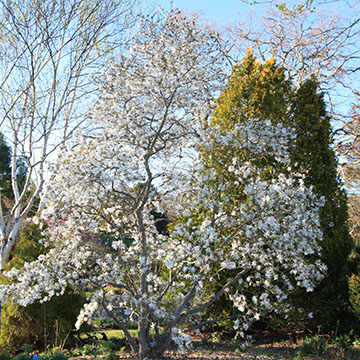 |
Cornus mas, Cornelian Cherry Dogwood flowers. |
Magnolia stellata 'Waterlily', is a double flowering form of the Star Magnolia. |
|
|
|
|
Magnolia stellata 'Waterlily' blooms in late-March to early April. |
Prunus x. 'Hally Jolivette' is clothed in delicate pink flowers. |
|
|
|
|
Prunus x. 'Hally Jolivette' blooms for a long time in early spring. |
Cercis canadensis 'Hearts of Gold' in full bloom with purplish-pink, pea-like flowers all along the stems. |
|
|
|
|
Cercis canadensis 'Hearts of Gold' with spring flowers and emerging yellow foliage. |
Cercis canadensis 'Hearts of Gold' lights up the summer garden. |
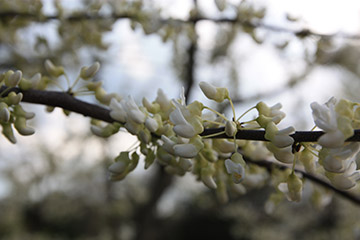 |
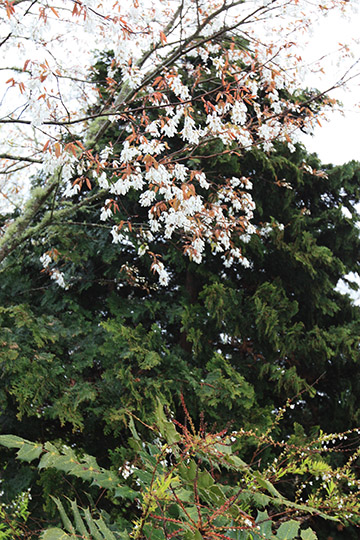 |
The branches of Cercis canadensis 'Alba' are covered in small white pea-like flowers in early spring. |
Amelanchier canadensis, Shad tree, blooms in late May to Early June. |
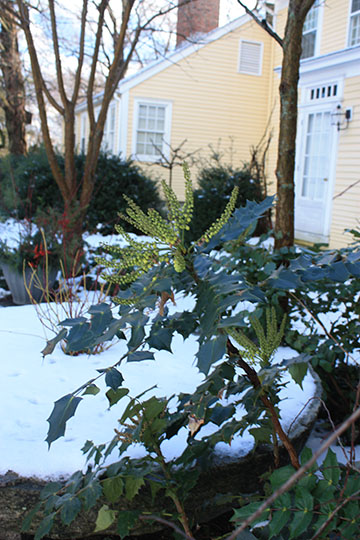 |
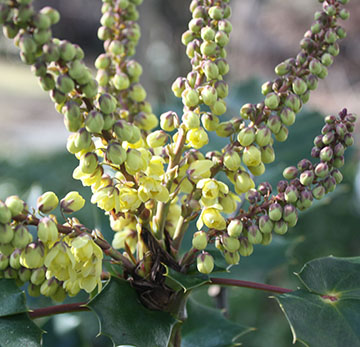 |
Mahonia bealei, the leather-leaf Mahonia has leaves that grow in horizontal tiers. |
The the fragrant yellow flowers of Mahonia bealei, bloom in late winter |
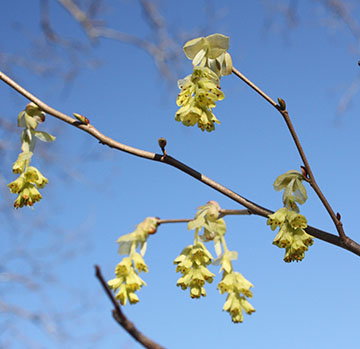 |
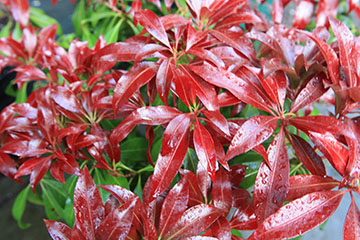 |
Golden Winter Hazel (Corylopsis spicata ‘Aurea’) produces clusters of drooping Amelanchier canadensis, Shad tree, blooms in late May to Early June. |
Pieris x 'Katsura' the dwarf variety of Japanese Andromeda offers dramatic, deep wine-red new growth. |
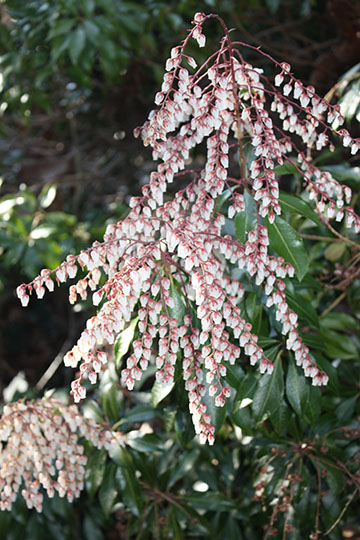 |
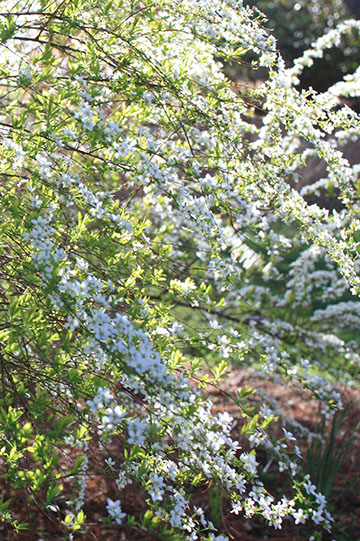 |
Pieris japonica 'Dorothy Wycoff' produces terminal clusters of bright red flower buds which open to fragrant white bells in early spring. |
Spiraea thunbergii 'Ogon' offers beauty from spring to fall with white flowers in early spring and chartreuse foliage all summer long. |

